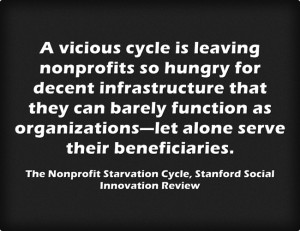Philanthropy, Not Fundraising
“Incremental Change is Not an Option.”
 What if this was your charity’s mantra? This is so different than “We keep overhead super low.” The first means dreaming on a large scale, and reaching for true solutions to social problems. The latter, not so much.
What if this was your charity’s mantra? This is so different than “We keep overhead super low.” The first means dreaming on a large scale, and reaching for true solutions to social problems. The latter, not so much.
For years donors have been taught to look for low overhead as a sign of effectiveness. When you stop to think about it, it makes little common sense. Who cares if you spend only 5 cents on the dollar if you only net $71 from your bake sale? Will this solve your problem? Whatever resources are needed to solve the problem, those are the resources that must be spent. Nothing more. Nothing less.
For too long we’ve confused morality with frugality. And, by so doing, we’ve missed the point. The bakesale with only 5% overhead that nets a paltry sum for charity because it invested so little is not better than the AIDS ride with 30% overhead that nets millions of dollars. And this is the whole point of the much ballyhooed TED talk by Dan Pallotta (if you’re not one of the 2+million who’ve listened in, you must).
 Guidestar, Charity Navigator and Better Business Bureau’s Wise Giving Alliance listened. Finally! They’ve done a 180. Yes, the former preachers of ‘the lower the overhead the more stars you get’ are now preaching a new sermon: Instead of rewarding charities for how little they spend, start rewarding charities for their big goals and accomplishments (even if that comes with big expenses).
Guidestar, Charity Navigator and Better Business Bureau’s Wise Giving Alliance listened. Finally! They’ve done a 180. Yes, the former preachers of ‘the lower the overhead the more stars you get’ are now preaching a new sermon: Instead of rewarding charities for how little they spend, start rewarding charities for their big goals and accomplishments (even if that comes with big expenses).
The recently launched “End The Overhead Myth” campaign makes a lot of sense. Does it matter so much what percentage you spend if you’re getting a 1,000% return on your investment? Honestly, when I worked in the trenches I consistently calculated and reported this sort of return. In the for-profit world folks would do cartwheels if they got this result! Not so in not-for-profit. Instead, staff would be asked to shave off a percentage point next year and raise more with less. Wrong perspective.
Charity needs to be judged from a different perspective. We need to look at two things: (1) what is needed to do the job and (2) what is accomplished. Period.
It’s not about how the donor feels about it. There are two concepts in Judaism that speak to this. They’ve helped me to understand philanthropy in a new light, so I share them with you here.
The first is t’rumah. It’s considered, coincidentally, ‘an offering that elevates’. Because the giver is rising to the need presented. It appears in Exodus in the instructions the Lord gives Moses for building the tabernacle, her dwelling-place, in their midst. For a mission as important as the Lord’s home something very specific was needed and it was crystal clear what the job required, down to the last cubit. Anything less would not have been enough. Anything more would have been excess. The focus is not on the money but on the accomplishment. Boiled down to its essence t’rumah means enough to get the job done.*
The second is tzedekah. The root of the word means justice. It essentially means doing the right thing from the perspective of the recipient. I often tell folks the following story, followed by the question “Which is better according to Judaism?” I share the story with you here so you can think about your answer; then I’ll reveal it:
You spot a beggar on the street. You feel great compassion for him and give him $10. The next person comes along and sees the same beggar. They are annoyed by him and wish he’d go away or get a job. They throw a $100 bill into his hat. Which is better?
Have your answer?
I’m always surprised by how many people say the $10 given with compassion is better. Really? Not from the perspective of the beggar who needs enough to buy dinner and find shelter for the night.
It’s beyond time to encourage charities, their boards and their supporters to spend what is needed to do the job. Show your board Dan Pallota’s TED talk. Send them the Nonprofit Starvation Cycle, Stanford Social Innovation Review. Check out the end the overhead myth’s new website and spread the word!
*By the way, those Israelites who built the tabernacle were given the Ten Commandments. That’s what I call social innovation!
This is the 11th post in the Philanthropy, Not Fundraising series — exploring the ways in which the former is transformational and donor-centric while the latter is merely transactional. Let me know what you think! What are your thoughts on the end the overhead myth campaign?
Speaking of common sense, do you ever feel it’s missing in your nonprofit’s planning and strategies? If so, get this practical Guide to Unlock Your Fundraising Potential complete with worksheets and individual + group exercises to help you wrap your arms around some areas of practice that tend to be fuzzy for too many folks. It will give you fresh insights into how fundraising and marketing have changed more in the past 5 years than in the previous 50.
Photo: Flickr Photo Pin, Christina Spicuzza






Brilliantly stated, Claire–thank you!
I agree with everything you’ve said, Claire, with one exception. “It’s not about how the donor feels about it.”
Donors are the customers that enable nonprofits to fulfill their missions. Not only must charities be mission-centric, they must also be customer-centric. They need to educate their donors and prospects on their business model, demonstrating successes. It’s like selling a product or service in the business sector. One must learn to overcome the customer’s objections – through sound marketing practices – in order to get the sale.
Shabbat Shalom. 🙂
Hi Elaine,
I absolutely concur that charities must be customer-centric. 100%! What I meant by my comment was that, within the religious tradition, what was important was the outcome achieved by the philanthropy — not so much that the philanthropist felt like this made them a ‘good person.’ I brought this up to make the very same point you are making: charities must demonstrate the outcomes they seek to achieve, and must persuade the potential donors that these outcomes are essential. In addition, charities must think big if they’re to solve big problems. Too many charities have still not retired the tin cup.
Thanks for the comment.
Claire,
Thank you for this article, it was insightful, interesting and thought provoking. I also took the time to watch Dan Pallotta’s talk on this topic. I am the director of a small not for profit agency that supports families who are impacted by mental health issues. While fundamentally I certainly can get behind what is being said here I would like to point out that it is not just our donors who stand on our coat tails about overhead but also our major stakeholders. We are not an organization who’s sole purpose is to raise funds for research etc. but rather we are a community based organization who is primarily funded by our provincial government, regional government & our local United Way. There is an expectation by these funders about expenses and revenues that can often be prohibitive to us in trying to raise any funds.
In Canada, years back, the Imagine program was implemented nationally and it was driven by the premise that companies who were making profits would be willing to donate 1% of their profits to the NFP sector. It has never really taken hold so NFP’s continue to struggle to raise funds.
The other challenge is how does a small organization (operating budgets of less than $1M) compete against monster campaigns of organizations from the likes of Heart & Stroke to Breast Cancer to the hospitals, who have whole departments dedicated to fundraising. Smaller organizations cannot afford to hire even one full time person to attempt to fundraise. Small organizations cannot carry the salary of employees for a few years in hopes of seeing the investment on return. It is a bit of a catch 22. I have a couple of board members who have spoken about hiring a fundraiser but at the end of the day I don’t have the capital in my budget whatsoever to cover those costs.
Respectfully,
Christine Cooper, Executive Director
Family Association for Mental Health Everywhere